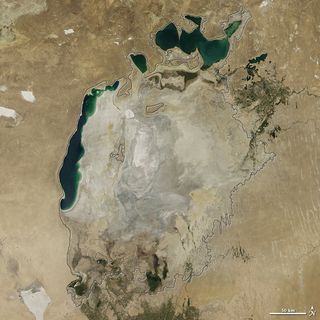Once-Massive Aral Sea Is Drying Up (Photos)

Once a sprawling oasis in the mostly arid Central Asian countries of Kazakhstan and Uzbekistan, the Aral Sea is now a fraction of its former self. Images captured by a NASA satellite show that the eastern basin of the South Aral Sea is now completely dry.
The two photos — one taken on Aug. 25, 2000, and the other taken on Aug. 19, 2014 — show the stark difference in the Aral Sea's appearance. The once-extensive waters of the eastern lobe (shown in emerald green in the satellite photos) have disappeared.
The Aral Sea, once the fourth largest lake in the world, began shrinking after the Soviet Union started diverting water from two large rivers — the Syr Darya and the Amu Darya — in the 1950s and 1960s. Dams, canals and other structures changed the surrounding desert into farmland for cotton and other crops. But, without the rivers, the Aral Sea began to disappear. [The 10 Biggest Deserts on Earth]
Fisheries and communities that depended on the lake also began to collapse. As it shrank, the lake became saltier and absorbed more pollution from agricultural fertilizer and pesticides. Salty dust from the exposed lakebed became a public health hazard, which in turn increased water demand, as farmers required more water to flush the salt out of their crops. The loss of the lake is also affecting the climate, with the region experiencing colder winters and hotter and drier summers.
"This is the first time the eastern basin has completely dried in modern times," Philip Micklin, a geographer emeritus at Western Michigan University in Kalamazoo, and an Aral Sea expert, said in a statement. "And it is likely the first time it has completely dried in 600 years, since medieval desiccation [or drying] associated with diversion of Amu Darya to the Caspian Sea."

Using the Moderate Resolution Imaging Spectroradiometer (MODIS) on its Terra satellite, NASA found that the Aral Sea has shrunk dramatically since the 1960s. Satellite photos from 2000 show that the lake had already split into a small North Aral Sea in Kazakhstan and a larger South Aral Sea in Uzbekistan. The South Aral later separated into western and eastern lobes.
This isn't the first time the eastern lobe has lost water. It almost dried up in 2009, but then rebounded in 2010 as water levels fluctuated between dry and wet years.
Sign up for the Live Science daily newsletter now
Get the world’s most fascinating discoveries delivered straight to your inbox.
Another dry spell hit the region this year. The Pamir Mountains, a watershed for the lake, received less rain and snow, which lowered water levels on the Amu Darya, Micklin said. Farmers also continue to use large amounts of water for irrigation.
The Kok-Aral Dam, which stretches across the Berg Strait, a waterway that connects the northern Aral Sea with its southern lake, also played a role, but the dam has not been a major factor this year, he said.
"This part of the Aral Sea is showing major year-to-year variations that are dependent on flow of Amu Darya," Micklin said. "I would expect this pattern to continue for some time."
Follow Laura Geggel on Twitter @LauraGeggel and Google+. Follow Live Science @livescience, Facebook & Google+. Original article on Live Science.

Laura is the archaeology and Life's Little Mysteries editor at Live Science. She also reports on general science, including paleontology. Her work has appeared in The New York Times, Scholastic, Popular Science and Spectrum, a site on autism research. She has won multiple awards from the Society of Professional Journalists and the Washington Newspaper Publishers Association for her reporting at a weekly newspaper near Seattle. Laura holds a bachelor's degree in English literature and psychology from Washington University in St. Louis and a master's degree in science writing from NYU.
